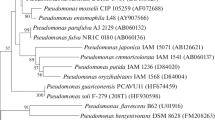Abstract
From various oxic or anoxic habitats several strains of bacteria were isolated which in the absence of molecular oxygen oxidized phenol to CO2 with nitrate as the terminal electron acceptor. All strains grew in defined mineral salts medium; two of them were further characterized. The bacteria were facultatively anaerobic Gramnegative rods; metabolism was strictly oxidative with molecular oxygen, nitrate, or nitrite as electron acceptor. The isolates were tentatively identified as pseudomonads. Besides phenol many other benzene derivatives like cresols or aromatic acids were anaerobically oxidized in the presence of nitrate. While benzoate or 4-hydroxybenzoate was degraded both anaerobically and aerobically, phenol was oxidized under anaerobic conditions only. Reduced alicyclic compounds were not degraded. Preliminary evidence is presented that the first reaction in anaerobic phenol oxidation is phenol carboxylation to 4-hydroxybenzoate.
Similar content being viewed by others
References
Aoki K, Shinke R, Nishira H (1984) Anthranilic acid production from aniline by Rhodococcus erythropolis AN-13. Agric Biol Chem 48:2309–2313
Aoki K, Uemori T, Shinke R, Nishira H (1985) Further characterization of bacterial production of anthranilic acid from aniline. Agric Biol Chem 49:1151–1158
Bak F, Widdel F (1986) Anaerobic degradation of phenol and phenol derivatives by Desulfobacterium phenolicum sp. nov. Arch Microbiol 146:177–180
Bakker G (1977a) Anaerobic degradation of aromatic compounds in the presence of nitrate. FEMS Lett 1:103–108
Bakker G (1977b) Degradation of aromatic compounds by microorganisms in dissimilatory nitrate reduction. Thesis University of Delft
Balba MT, Evans WC (1980) The methanogenic biodegradation of catechol by a microbial consortium: evidence for the production of phenol through cis-benzenediol. Biochem Soc Trans 8:452–453
Bossert ID, Young LY (1986) Anaerobic oxidation of p-cresol by a denitrifying bacterium. Appl Environ Microbiol 52:1117–1122
Braunegg G, Sonnleitner B, Lafferty RM (1978) A rapid gas chromatographic method for the determination of poly-β-hydroxybutyric acid in microbial biomass. Eur J Appl Microbiol Biotechnol 6:29–37
Chmielowski J, Grossman A, Labuzek S (1965) Biochemical degradation of some phenols during the methane fermentation. Zeszyty Naukowe Politechniki Slaskiej-Inzynieria Sanitarna 8:97–122
Curtius HC, Mettler M, Ettlinger L (1976) Study of the intestinal tyrosine metabolism using stable isotopes and gas chromatography-mass spectrometry. J Chromatogr 126:569–580
Dagley S (1975) A biochemical approach to some problems of environmental pollution. Essays Biochem 11:81–138
Dutton PL, Evans WC (1969) The metabolism of aromatic compounds by Rhodopseudomonas palustris. A new, reductive method of aromatic ring metabolism. Biochem J 113:525–536
Evans WC (1977) Biochemistry of the bacterial catabolism of aromatic compounds in anaerobic environments. Nature (Lond) 270:17–22
Gregerson T (1978) Rapid method for distinction of Gram-negative from Gram-positive bacteria. Eur J Appl Microbiol Biotechnol 5:123–127
Hill GA, Robinson GW (1975) Substrate inhibition kinetics: phenol degradation by Pseudomonas putida. Biotechnol Bioeng 17: 1599–1615
Jones GL, Jansen F, McKay AJ (1973) Substrate inhibition of the growth of Bacterium NCTB 8250 by phenol. J Gen Microbiol 74:139–148
Knoll G, Winter J (1987) Anaerobic degradation of phenol in sewage sludge. Benzoate formation from phenol and CO2 in the presence of hydrogen. Appl Microbiol Biotechnol 25:384–391
Pfennig N (1978) Rhodocyclus purpureus gen. nov. and sp. nov., a ring-shaped, vitamin B12-requiring member of the family Rhodospirillaceae. Int J Syst Bacteriol 28:283–288
Scheline RR (1966) Decarboxylation and demethylation of some phenolic benzoic acid derivatives by rat caecal contents. J Pharm Pharmac 18:664–669
Sleat R, Robinson JP (1984) The bacteriology of anaerobic degradation of aromatic compounds. J Appl Bacteriol 57:381–394
Tarvin D, Buswell AM (1934) The methane fermentation of organic acids and carbohydrates. J Am Chem Soc 56:1751–1755
Taylor BF, Campbell WL, Chinoy I (1970) Anaerobic degradation of the benzene nucleus by a facultatively anaerobic microorganism. J Bacteriol 102:430–437
Tschech A, Pfennig N (1984) Growth yield increase linked to caffeate reduction in Acetobacterium woodii. Arch Microbiol 137:163–167
Tschech A, Schink B (1986) Fermentative degradation of monohydroxybenzoates by defined synthrophic cocultures. Arch Microbiol 145:396–402
Widdel F, Kohring GW, Mayer F (1983) Studies on dissimilatory sulfate-reducing bacteria that decompose fatty acids. III. Characterization of the filamentous gliding Desulfonema limicola gen. nov. sp. nov., and Desulfonema magnum sp. nov. Arch Microbiol 134:286–294
Williams RJ, Evans EC (1975) The metabolism of benzoate by Moraxella species through anaerobic nitrate respiration: evidence for a reductive pathway. Biochem J 148:1–10
Young LY (1984) Anaerobic degradation of aromatic compounds. In: Gibson DT (ed) Microbial degradation of organic compounds. Marcel Dekker, New York, pp 487–523
Author information
Authors and Affiliations
Rights and permissions
About this article
Cite this article
Tschech, A., Fuchs, G. Anaerobic degradation of phenol by pure cultures of newly isolated denitrifying pseudomonads. Arch. Microbiol. 148, 213–217 (1987). https://doi.org/10.1007/BF00414814
Received:
Accepted:
Issue Date:
DOI: https://doi.org/10.1007/BF00414814




